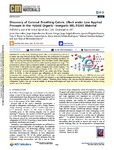Mostrar o rexistro simple do ítem
Discovery of Colossal Breathing-Caloric Effect under Low Applied Pressure in the Hybrid Organic–Inorganic MIL-53(Al) Material
| dc.contributor.author | García Ben, Javier | |
| dc.contributor.author | López-Beceiro, Jorge | |
| dc.contributor.author | Artiaga, Ramón | |
| dc.contributor.author | Salgado-Beceiro, Jorge | |
| dc.contributor.author | Delgado Ferreiro, Ignacio | |
| dc.contributor.author | Kolen'ko, Yury V. | |
| dc.contributor.author | Castro-García, Socorro | |
| dc.contributor.author | Señarís-Rodríguez, M. A. | |
| dc.contributor.author | Sánchez-Andújar, Manuel | |
| dc.contributor.author | Bermúdez-García, Juan Manuel | |
| dc.date.accessioned | 2022-06-30T09:05:02Z | |
| dc.date.available | 2022-06-30T09:05:02Z | |
| dc.date.issued | 2022-03-30 | |
| dc.identifier.citation | García-Ben, J.; López-Beceiro, J.; Artiaga, R.; Salgado-Beceiro, J.; Delgado-Ferreiro, I.; Kolen’ko, Y. V.; Castro-García, S.; Señarís-Rodríguez, M. A.; Sánchez-Andújar, M.; Bermúdez-García, J. M. Discovery of Colossal Breathing-Caloric Effect under Low Applied Pressure in the Hybrid Organic–Inorganic MIL-53(Al) Material. Chem. Mater. 2022, 34 (7), 3323–3332. https://doi.org/10.1021/acs.chemmater.2c00137 | es_ES |
| dc.identifier.issn | 0897-4756 | |
| dc.identifier.issn | 1520-5002 | |
| dc.identifier.uri | http://hdl.handle.net/2183/31044 | |
| dc.description | Financiado para publicación en acceso aberto: Universidade da Coruña/CISUG | es_ES |
| dc.description.abstract | [Abstract] In this work, “breathing-caloric” effect is introduced as a new term to define very large thermal changes that arise from the combination of structural changes and gas adsorption processes occurring during breathing transitions. In regard to cooling and heating applications, this innovative caloric effect appears under very low working pressures and in a wide operating temperature range. This phenomenon, whose origin is analyzed in depth, is observed and reported here for the first time in the porous hybrid organic–inorganic MIL-53(Al) material. This MOF compound exhibits colossal thermal changes of ΔS ∼ 311 J K–1 kg–1 and ΔH ∼ 93 kJ kg–1 at room temperature (298 K) and under only 16 bar, pressure which is similar to that of common gas refrigerants at the same operating temperature (for instance, p(CO2) ∼ 64 bar and p(R134a) ∼ 6 bar) and noticeably lower than p > 1000 bar of most solid barocaloric materials. Furthermore, MIL-53(Al) can operate in a very wide temperature range from 333 K down to 254 K, matching the operating requirements of most HVAC systems. Therefore, these findings offer new eco-friendly alternatives to the current refrigeration systems that can be easily adapted to existing technologies and open the door to the innovation of future cooling systems yet to be developed. | es_ES |
| dc.description.sponsorship | This work was financially supported by Ministerio de Economía y Competitividad MINECO and EU-FEDER (projects MAT2017-86453-R and PDC2021-121076-I00), Xunta de Galicia and IACOBUS Programme. Funding for open access fee was provided by Universidade da Coruña/CISUG | es_ES |
| dc.language.iso | eng | es_ES |
| dc.publisher | American Chemical Society | es_ES |
| dc.relation | info:eu-repo/grantAgreement/AEI/Plan Estatal de Investigación Científica y Técnica y de Innovación 2017-2020/MAT2017-86453-R/ES/MATERIALES HIBRIDOS ORGANICO-INORGANICOS PARA APLICACIONES DE REFRIGERACION ECOLOGICAS/ | |
| dc.relation | info:eu-repo/grantAgreement/AEI/Plan Estatal de Investigación Científica y Técnica y de Innovación 2017-2020/PDC2021-121076-I00/ES/ | |
| dc.relation.uri | https://doi.org/10.1021/acs.chemmater.2c00137 | es_ES |
| dc.rights | Atribución 4.0 Internacional | es_ES |
| dc.rights.uri | http://creativecommons.org/licenses/by/4.0/ | * |
| dc.title | Discovery of Colossal Breathing-Caloric Effect under Low Applied Pressure in the Hybrid Organic–Inorganic MIL-53(Al) Material | es_ES |
| dc.type | info:eu-repo/semantics/article | es_ES |
| dc.rights.access | info:eu-repo/semantics/openAccess | es_ES |
| UDC.journalTitle | Chemistry of Materials | es_ES |
| UDC.volume | 34 | es_ES |
| UDC.issue | 7 | es_ES |
| UDC.startPage | 3323 | es_ES |
| UDC.endPage | 3332 | es_ES |
| dc.identifier.doi | 10.1021/acs.chemmater.2c00137 |






